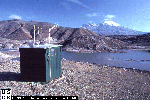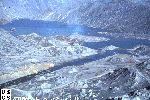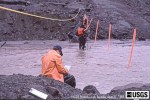|
Sediment Erosion, Transport, and Deposition
|
Rivers with headwaters in the blast area have a rapid streamflow response to
rainfall, owing to reduced infiltration rates on hillslopes and low roughness
along channels. Streams now respond more quickly to a given amount of rainfall
and produce higher peak flows as rainfall is quickly flushed through the
drainage system. Greater streamflow increases the erosion and transportation
of sediment from hillslopes and river channels; deposition of this debris in the
lower reaches of the Toutle and Cowlitz Rivers reduces channel depths, thereby
increasing the possibility of flooding.
Flood levees, channel dredging, and
debris-retention structures built by the U.S. Army Corps of Engineers have thus
far prevented serious flooding to communities along the Toutle and Cowlitz
Rivers.
|
Water and Sediment Discharge Measurements
|
Thirteen gaging stations were constructed after the May 18 eruption to measure
water and sediment discharge of the rivers draining Mount St. Helens; these
stations supplement those already in place on reservoirs and rivers around the
volcano. Gaging stations continuously record the water-surface elevation or
stage of a river. Stream discharge is calculated from the relationship between
this recorded stage and periodic manual discharge measurements. Hydrologists
also collect water samples at the gage sites and analyze them to determine total
suspended sediment transported by the streams.
The network of river gages provide information for flood forecasting and for
long-term sediment-transport trends. These data are used by the National
Weather Service to warn of severe flooding conditions and by the Corps of
Engineers to develop sediment-control solutions.
Since May 18, 1980, sediment transport rates for the rivers flanking Mount St.
Helens, especially the Toutle River, have been among the highest in the world.
More than 20 million tons of suspended sediment was transported from the Toutle
River basin in the first 7 months after the May 18, eruption, or 15 million tons
in only 13 days. About 39 million tons of suspended sediment was transported
from October 1981 to September 1982, enough to cover an average city block to a
depth of 8 kilometers. Since 1980, storms have been of only low to moderate
intensity; consequently, less than 5 percent of the total volume of the
avalanche deposit has been removed by erosion, so it will persist as a
sediment-management problem for many years.
More than 150 cross-sections of river channels are surveyed regularly to
determine areas of erosion and deposition along rivers draining Mount St.
Helens. These repetitive surveys measure bank and channel erosion and channel
deposition at specific locations. Repeated aerial photographs also are used to
identify sediment sources and sinks.
In many places since the 1980 eruptions, channel modifications have been equal
to or greater than those resulting directly from the damaging lahars on May
18. Generally, erosion and sediment transport by channel widening and
downcutting dominate the upper reaches of the drainage basins, and aggradation
and sediment transport dominate the lower reaches.
The debris avalanche raised the level of Spirit Lake 64 meters and dammed its
natural outlet even higher. ...
and several lakes formed in tributaries dammed by the
avalanche; the largest lakes formed in the tributaries of Coldwater and Castle
Creeks. ... Failure of the debris dams holding Spirit, Coldwater, and Castle
Lakes would result in catastrophic mudflows comparable to or larger than those
of May 18, 1980. Controlled outflow channels have been constructed to stabilize
the water levels ...
Six lake gages, maintained by the Geological Survey in cooperation with the
National Weather Service and the Federal Emergency Management Agency, monitor
the water levels of Spirit, Coldwater, and Castle Lakes. The gages serve as an
emergency warning system if one of the debris dams fails. Each gage has at
least two recording instruments that transmit several lake elevations each hour
by way of a satellite to a ground receiving station in Tacoma, Washington. If a
lake level drops faster than the specified rate, alert transmissions send lake
elevations every 5 minutes.
Overtopping of the debris dams due to filling from normal precipitation was
considered to be the most likely cause of lake breakouts and resulting floods;
controlled outlet channels and the Spirit Lake pumping operation have eliminated
this possibility. However, a sudden influx of a large volume of volcanic debris
from an eruption of Mount St. Helens could raise rapidly the level of Spirit
Lake. An eruption producing pyroclastic flows more voluminous than those of May
18, 1980, would be necessary to cause overtopping.
Several geologic and geophysical studies evaluate and monitor the potential
instability of unconsolidated material that blocks the lakes.
Failure of these debris dams could result from slumping of the dams,
liquefaction from shaking during earthquakes, or headward erosion of gullies and
channels. The studies suggest, however, that these possibilities are unlikely in
the near future.
A seismic zone about 1,000 kilometers long trends north-northwest through Mount
St. Helens and beneath the debris-avalanche deposit. During recent decades,
several significant earthquakes have occurred along this zone, the largest of
which was magnitude 5.5 and occurred in February 1981. Ground-water
wells and seismometers on the surface of the avalanche deposit and in holes 6 to
30 meters deep are used to monitor the response of the unconsolidated debris to
earthquake activity.
The relatively narrow debris blockage at Castle Lake is most subject to
slumping or gravitational failure.
Instruments in drill holes as deep as 30 meters monitor
slope movements of the Castle and Spirit Lake dams, and ground-water tables are
recorded at all three lake blockages. Erosion is monitored by repeated
photographs and channel geometry surveys.
The Hydrologic Monitoring Program provides hazard information and improves
understanding of the hydrologic processes involved in the devastation and
recovery of areas affected by the May 18, 1980 eruption and lahars.
Information collected by the monitoring techniques are used to investigate
factors affecting the stability of stream channels and the fluid dynamics of
flows that transport high sediment loads.
The May 18 lahar deposits and small debris flows that continue to occur on the
volcano also help hydrologists to interpret deposits in the historic record at
Mount St. Helens and other Cascade volcanoes. Newly recognized pre-1980 lahar
deposits in the Toutle River valley are interpreted to have been emplaced from
previous breakouts of Spirit Lake. Lahar-hazards studies on Mount Hood Volcano
in northern Oregon also have been aided greatly by the study of recent deposits
at Mount St. Helens.
Mount St. Helens offers an unusual opportunity to study the flow characteristics
of lahars and debris flows and to develop models for predicting their behavior
and effects downstream. Information from these studies and the development of
better scientific techniques will continue to improve understanding and the
expertise needed to manage water resource problems caused by future volcanic
eruptions.
 [Image,241K,GIF]
[Image,241K,GIF]
 [Image,264K,GIF]
[Image,264K,GIF]
 [Image,200K,GIF]
[Image,200K,GIF]
 MORE Photo Archives
MORE Photo Archives

